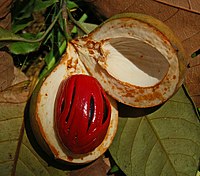
Photo from wikipedia
Calmodulin (CaM) serves as an important Ca2+ signaling hub that regulates many protein signaling pathways. Recently, it was demonstrated that plant CaM homologues can regulate mammalian targets, often in a… Click to show full abstract
Calmodulin (CaM) serves as an important Ca2+ signaling hub that regulates many protein signaling pathways. Recently, it was demonstrated that plant CaM homologues can regulate mammalian targets, often in a manner that opposes the impact of the mammalian CaM (mCaM). However, the molecular basis of how CaM homologue mutations differentially impact target activation is unclear. To understand these mechanisms, we examined two CaM isoforms found in soybean plants that differentially regulate a mammalian target, calcineurin (CaN). These CaM isoforms, sCaM-1 and sCaM-4, share >90 and ∼78% identity with the mCaM, respectively, and activate CaN with comparable or reduced activity relative to mCaM. We used molecular dynamics (MD) simulations and fluorometric assays of CaN-dependent dephosphorylation of MUF-P to probe whether calcium and protein-protein binding interactions are altered by plant CaMs relative to mCaM as a basis for differential CaN regulation. In the presence of CaN, we found that the two sCaMs' Ca2+ binding properties, such as their predicted coordination of Ca2+ and experimentally measured EC50 [Ca2+] values are comparable to mCaM. Furthermore, the binding of CaM to the CaM binding region (CaMBR) in CaN is comparable among the three CaMs, as evidenced by MD-predicted binding energies and experimentally measured EC50 [CaM] values. However, mCaM and sCaM-1 exhibited binding with a secondary region of CaN's regulatory domain that is weakened for sCaM-4. We speculate that this secondary interaction affects the turnover rate (kcat) of CaN based on our modeling of enzyme activity, which is consistent with our experimental data. Together, our data describe how plant-derived CaM variants alter CaN activity through enlisting interactions other than those directly influencing Ca2+ binding and canonical CaMBR binding, which may additionally play a role in the differential regulation of other mammalian targets.
Journal Title: Journal of chemical information and modeling
Year Published: 2021
Link to full text (if available)
Share on Social Media: Sign Up to like & get
recommendations!